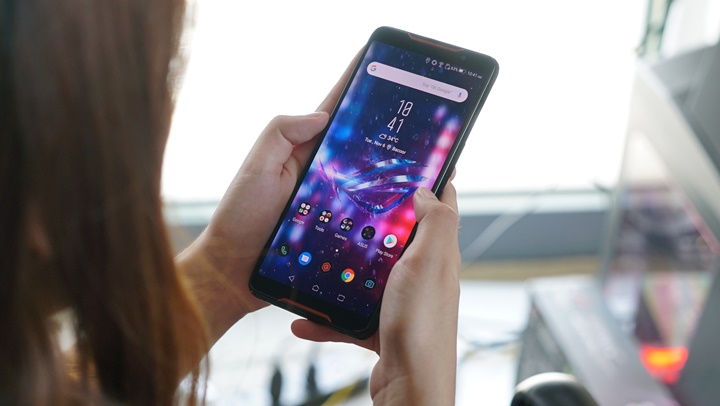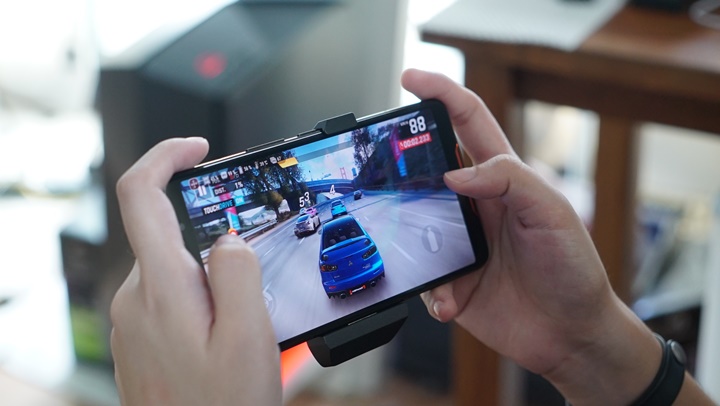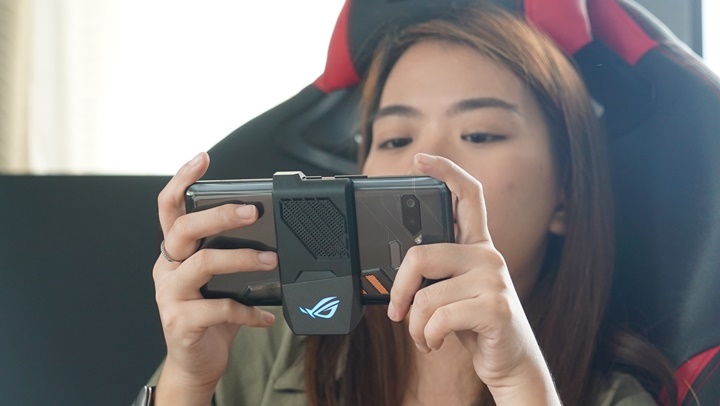It’s been five months since ASUS ROG revealed the ROG Phone at Computex 2018 in Taiwan. It’s not just a smartphone with flagship specs, but is also packed features designed to improve a user’s mobile gaming experience. But are they necessary? Is it worth the price? Can it deliver? We have the answers to all those questions in our review below.
Table of Contents
As ASUS ROG’s first gaming smartphone, the ROG Phone looks very different from the ZenFones that we’re used to. They definitely didn’t hold back in the design to make sure that it can be easily identified as a phone designed for gaming at first glance.

Starting at the front of the device, we have the 6-inch screen with slim top and bottom bezels that houses the dual stereo speakers with copper detailing as well as the 8MP selfie camera.

On the left are the dual-nano SIM card tray and the USB-C-based port for the AeroActive Cooler accessory and for charging. If you have to charge the phone from this side, do note that you have to plug it on the black pin and not on the orange one. When not in use, these ports can be covered by a rubber plug. Charging the phone using the side port makes it easier to hold when playing games in landscape orientation.

On the right are the microphone, and the volume and power/lock buttons. The buttons are firm and clicky, and they’re also easy to reach as they are placed near the middle of the frame.
Up top, we have another hole for the microphone, along with a pair of antenna bands.

While down at the bottom are the main microphone, USB-C port, and the 3.5mm audio port which is nice as you can use your favorite wired headphones.

The backside is where it all gets visually busy as it has the dual rear cameras, LED flash, fingerprint scanner, the ROG AeroDynamic System where you can see a portion of the copper heat spreader, and the RGB backlit ROG logo.
The ROG Phone really stands out from this side. Instead of circles and curves, it uses sharp geometric shapes and futuristic styling to highlight the components. Compared to other “non-gaming” smartphones, this one looks more exciting and definitely looks more at home with other ROG products than the ZenFone.

In terms of quality, the ROG Phone definitely has everything it needs to be called premium. It has a matte metal frame, a 2.5D Corning Gorilla Glass 6 on the front, and a 3D Corning Gorilla Glass at the back. It also has water-resistance although ASUS has not specified its IP rating.
In the hands, the ROG Phone is a bit chunky at 8.6mm and hefty 200g, but that’s understandable considering the build and large battery. It’s still relatively narrow so it’s still easy to grip, although navigation of the UI is best done with two hands.
Given its premium nature, you might want to protect it with a case. Good thing ASUS ROG already has its own specially-designed case included in the package.
The ROG Phone is equipped with a 6-inch AMOLED screen with Full HD+ resolution or equal to 402ppi. The screen is rich and vibrant with punchy yet accurate colors, has great viewing angles, and even comes with HDR mode to improve viewing experience especially when watching movies. What we like the most though is the 90Hz refresh rate for that smooth UI animations.

Going inside the settings and you’ll see more features and customization options like the toggle for Smart screen on which extends the screen on time while you’re looking at it or while holding the device upright, Always-on Panel if you want to see information on the screen even when the device is locked, Lift to check phone, option to choose between 60Hz or 90Hz refresh rate, and access to ASUS Splendid so you can set color temperatures and color modes.

When it comes to audio, the ROG Phone has two front-facing 5-magnet speakers with NXP 9874 amplifiers. They’re one of the nicest and most powerful speakers we’ve encountered so far. It’s crisp, has a hint of bass but still lacking. They’re loud enough that we often never found the need to use external speakers in a small room.

If you’re craving Hi-Res audio, the ROG Phone supports such audio files thanks to the 24-bit/192KHz audio engine and even has support for DTS Headphone:X and Qualcomm aptX for high-definition Bluetooth wireless audio. If you want to further tweak its audio settings, you can do so via the ASUS AudioWizard.
The ROG Phone uses the same camera configuration found on the ZenFone 5Z. It has a dual rear camera setup consisting of a 12MP Sony IMX363 main camera with F1.8 aperture and 8MP 120-degrees wide-angle camera. For selfies, it has an 8MP F2.0 camera. It has the same features as well like Beauty, Depth Effect, Super-Resolution, Panorama, Time-Lapse, Auto, Pro, GIF animation, Slow Motion, and a set of filters, but this time it has Google Lens.

Camera performance and quality are the same as the ZenFone 5Z. The photos have good detail on them with rich yet accurate colors. It still performs decently in low-light conditions and has this feature called Night HDR. The performance is different though when it comes to the secondary wide-angle sensor as images are not as sharp while colors are not as vibrant. Low-light performance is also poor.
As for the front camera, selfies come out nice and detailed and comes with beauty and portrait mode as well. They work but sometimes the results look artificial. What we like using though is the ZeniMoji feature which is basically an animated emoji. You can choose from 11 characters with the option to change the background color.
When it comes to video recording, the ROG Phone can shoot videos at a maximum of 4K resolution at 30fps with video stabilization or 60fps without. Quality is good and so far has done a decent job in removing minor shakes in our shots. Watch the sample below:
Running the software for the ROG Phone is Android 8.1 Oreo with a new skin called ROG Gaming X mode UI. It’s different from ZenUI as it has its own set of icons and wallpapers, and uses a darker theme with orange accents.

It’s still a simple and familiar UI though and uses an app drawer to house your installed apps while navigation is done either via on-screen navigation keys or via gestures. It also has ZenMotion which is basically quick commands that are based on touch and motion gestures.

Inside settings, you’ll have access to a wide variety of features like Twin Apps, Game Genie, SafeGuard, which is like a panic button which allows you to quickly make SOS calls and send SMS during emergencies, and a number of AI Features like OptiFlex which speeds up app launches, and AI charging and AI ringtone.

As for apps, the ROG Phone comes with the usual Google and ASUS apps. A lot of these apps will ask for an update upon first boot, but most of them seem essential so we don’t mind it.

Storage-wise, we’re getting 107.74GB of usable space out of the 128GB, which should be enough for most heavy users. The only downside is that it doesn’t have a microSD card slot.
Powering the ROG Phone is a speed-binned Qualcomm Snapdragon 845 octa-core processor clocked at 2.96GHz (the normal SD845 is clocked at 2.8GHz), Adreno 630 GPU, and 8GB of RAM. With this kind of hardware configuration, we already know that this phone can perform and run graphics-intensive games, so we’re just going to focus on how well it does it and what it uses to deliver that performance or experience.

Let’s start with the Game Center. This is similar to the Game Center found in ROG PCs and is a dashboard where you can see device information like CPU, GPU, and memory usage. Right below it is X Mode which, when activated, optimizes the phone’s resources like the RAM to make sure that there are no bottlenecks when you run your game.

Also found here is the Game Profiles section which will show all the games you have installed on the ROG Phone. When you access a game’s profile, you will be given access to advanced options that you can customize like the CPU frequency, display refresh rate, even toggle anti-aliasing.

Next is Aura Lighting which activates the RGB light effect at the back of the ROG Phone. From here you can also change the colors, choose a light effect (static, breathing, strobing, color cycle), or activate light synchronization which is cool if you’re gaming with friends who also have ROG Phones.
When it comes to thermals, the phone itself already has a built-in cooling system called ROG GameCool. It consists of carbon cooling pads, copper heat spreader, and a 3D vapor-chamber, which absorbs the heat from the circuit board. On its own, this system does a good job at dissipating heat, but in case you need more cooling power, that’s where the AeroActive Cooler comes in.

The AeroActive Cooler clamps onto the ROG Phone and connects at the ports on the sides. It blows air at the back of the phone for an added cooling effect, In addition, it also has an illuminated RGB logo at the back, and at the bottom, a USB-C port for charging and 3.5mm audio port. The ports were strategically placed there so cables won’t get in the way when you charge the phone while gaming.
So far it’s doing its job well and was able to blow away the heat from the back off the phone. Not to mention, it also keeps our fingers from getting sweaty. You can also control its fan speed at the Game Center but in our case, we just put it in Auto.

Another feature that we find really cool is he AirTriggers which are pressure-sensitive sensors that are located at the upper and lower sides of the ROG Phone. When the AirTriggers are activated, they can perform different functions when squeezed. In portrait mode, it can launch apps like Game Suite, Google Assistant, even the camera. In landscape mode while gaming, it will serve as additional buttons or triggers similar to game controllers of popular consoles.

You can activate it by launch Game Genie while in the game (swipe from the right side edge to the left then tap on Game Genie icon) the tap on AirTriggers. From there just place where you want the L1 and R1 virtual buttons to be and it will trigger those buttons when you press the phone’s edges. It feels awkward at first as the only feedback you’ll get is haptics, but you’ll get used to it eventually.

As for the gaming experience, the ROG Phone can certainly deliver. We played popular titles on it which includes Asphalt 9, Mobile Legends, Tekken, Honkai Impact 3, Ragnarok M, and Dragon Nest M, and all of them ran smoothly. PUBG Mobile in HDR graphics, Ultra frame-rate, with anti-aliasing mode, managed to maintain frame rates above 40fps at temperatures not exceeding 40C. That’s some chill gaming. Check out the benchmarks below:
Note that these are new sets of benchmarks and was done with X Mode activated and the AeroActive Cooler attached.

• AnTuTu – 280,841
• 3D Mark – 4,543 (SSE – OpenGL ES 3.1), 3,659 (SSE – Vulkan)
• PC Mark – 8,931 (Work 2.0)
• Geekbench 4 – 2,521 (Single-Core), 7,830 (Multi-Core), 13,873 (RenderScript)
• AndroBench – 707.49 MB/s (Read), 204.53 MB/s (Write)
The ROG Phone has all the connectivity features covered which include dual-SIM support, 4G LTE Cat.18, WiFi 802.11ac/ad 2×2 MIMO with support for the ASUS WiGig dock, Bluetooth 5.0, NFC, GPS, 3.5mm audio jack, and two USB-C ports. Call quality is good while mobile data is fast, but that depends on your area and the telco. Apps like Google Maps, Waze, and Grab, also didn’t have any issues pinpointing our location.

Providing juice to the ROG Phone is a 4,000mAh battery. Mixed usage which includes gaming still got us a whole day with more left for the night. Although we noticed a shorter battery life when we keep 90Hz refresh rate and HDR visuals on. PC Mark rated the battery at 11 hours and 2 minutes with 60Hz HDR off, and 8 hours and 40 minutes with 90Hz HDR on. Our video loop test, on the other hand, got us 14 hours and 15 minutes with 90Hz, HDR on, which is good.
The ASUS HyperCharge is what also impressed us about this device. The power adapter can output 10V 3A and can charge the ROG Phone in just 1 hour and 45 minutes, which is really fast.
We have to give credit to ASUS for launching a phone such as the ROG Phone as it is not just your typical smartphone with powerful specs. It’s definitely designed for gaming which is evident in its looks, features, and accessories, and those are the things that give it an edge over its competitors. To cut it short, yes, the ROG Phone is one of the best gaming smartphones in the market and it’s not hard to imagine seeing it in the hands of mobile eSports teams.

As for the price, it’s the company’s most expensive device as of writing with a base price of PHP 49,995USD 852INR 72,223EUR 811CNY 6,204 (8GB + 128GB), which is still lower compared to other flagship smartphones in the market. However, if you want to have all the accessories for that complete gaming experience, that’s where it gets really pricey at PHP 108,465USD 1,848INR 156,689EUR 1,760CNY 13,461 base.
To conclude, can the ROG Phone deliver? Yes! Is it necessary and worth the price? If you’re a solid mobile gamer and want to bring your gaming experience to the next level, AND have the budget for it, then it’s a yes.
The ROG Phone is priced at PHP 49,995USD 852INR 72,223EUR 811CNY 6,204 (8GB + 128GB) and PHP 61,995USD 1,056INR 89,558EUR 1,006CNY 7,694 (8GB +512GB) and is up for pre-order until November 8, 2018. Retail units come with free ROG Phone Jacket, ROG Phone Case, and AeroActive Cooler accessory. The ROG Phone with complete accessories (TwinView Station Dock, WiGig, Mobile Desktop Dock, Gamevice, Professional Dock, and ROG suitcase) is priced at PHP 108,465USD 1,848INR 156,689EUR 1,760CNY 13,461 (8GB + 128GB) and PHP 120,465USD 2,053INR 174,024EUR 1,955CNY 14,950 (8GB +512GB).
ASUS ROG Phone specs:
6-inch FHD+ (2160 x 1080) 18:9 AMOLED display, 402ppi, 108.6% DCI-P3 color gamut
Corning Gorilla Glass 6
90Hz refresh rate, 1ms response time
HDR
Qualcomm Snapdragon 845 2.96GHz octa-core processor
Adreno 630 GPU
LPDDR4 8GB RAM
128GB/512GB UFS 2.1 internal storage
12MP Sony IMX363 1.4um, 1/2.55” w/ f/1.8 Night HDR, OIS/EIS, PDAF main
8MP 120-degrees wide-angle secondary
8MP f/2.0 front camera
4G LTE Cat. 18
Wi-Fi 802.11a/b/g/n/ac/ad, 2×2 MIMO
Wi-Fi Direct and WiGig wireless display support
Bluetooth 5.0
NFC
GPS, A-GPS, Glonass, and BeiDou
Custom USB Type-C port (side) w/ HyperCharge
USB 2.0 Type-C (bottom) w/ Fast charging
3.5mm audio port
Dual front-facing stereo speakers with Smart amplifier (24-bit/192KHz Hi-Res audio)
DTS Headphone:X™ 7.1 virtual surround-sound
Advanced vibration
2x AirTrigger sensors
Fingerprint sensor
GameCool vaper-chamber cooling system w/ detachable AeroActive Cooler
ASUS RGB lighting support
ASUS Aura Sync support
4,000mAh battery with HyperCharge technology
158.8 x 76.2 x 8.6mm
200g
What we liked:
• Good build
• Well-thought-of design
• Top-notch performance
• Plenty of gaming features and support for accessories
• Good battery life
• Good cameras
• Comes with AeroActive Cooler
• Side USB Type-C port and headphone jack (via AeroActive Cooler)
What we didn’t:
• Pricey accessories

YugaTech.com is the largest and longest-running technology site in the Philippines. Originally established in October 2002, the site was transformed into a full-fledged technology platform in 2005.
How to transfer, withdraw money from PayPal to GCash
Prices of Starlink satellite in the Philippines
Install Google GBox to Huawei smartphones
Pag-IBIG MP2 online application
How to check PhilHealth contributions online
How to find your SIM card serial number
Globe, PLDT, Converge, Sky: Unli fiber internet plans compared
10 biggest games in the Google Play Store
LTO periodic medical exam for 10-year licenses
Netflix codes to unlock hidden TV shows, movies
Apple, Asus, Cherry Mobile, Huawei, LG, Nokia, Oppo, Samsung, Sony, Vivo, Xiaomi, Lenovo, Infinix Mobile, Pocophone, Honor, iPhone, OnePlus, Tecno, Realme, HTC, Gionee, Kata, IQ00, Redmi, Razer, CloudFone, Motorola, Panasonic, TCL, Wiko
Best Android smartphones between PHP 20,000 - 25,000
Smartphones under PHP 10,000 in the Philippines
Smartphones under PHP 12K Philippines
Best smartphones for kids under PHP 7,000
Smartphones under PHP 15,000 in the Philippines
Best Android smartphones between PHP 15,000 - 20,000
Smartphones under PHP 20,000 in the Philippines
Most affordable 5G phones in the Philippines under PHP 20K
5G smartphones in the Philippines under PHP 16K
Smartphone pricelist Philippines 2024
Smartphone pricelist Philippines 2023
Smartphone pricelist Philippines 2022
Smartphone pricelist Philippines 2021
Smartphone pricelist Philippines 2020